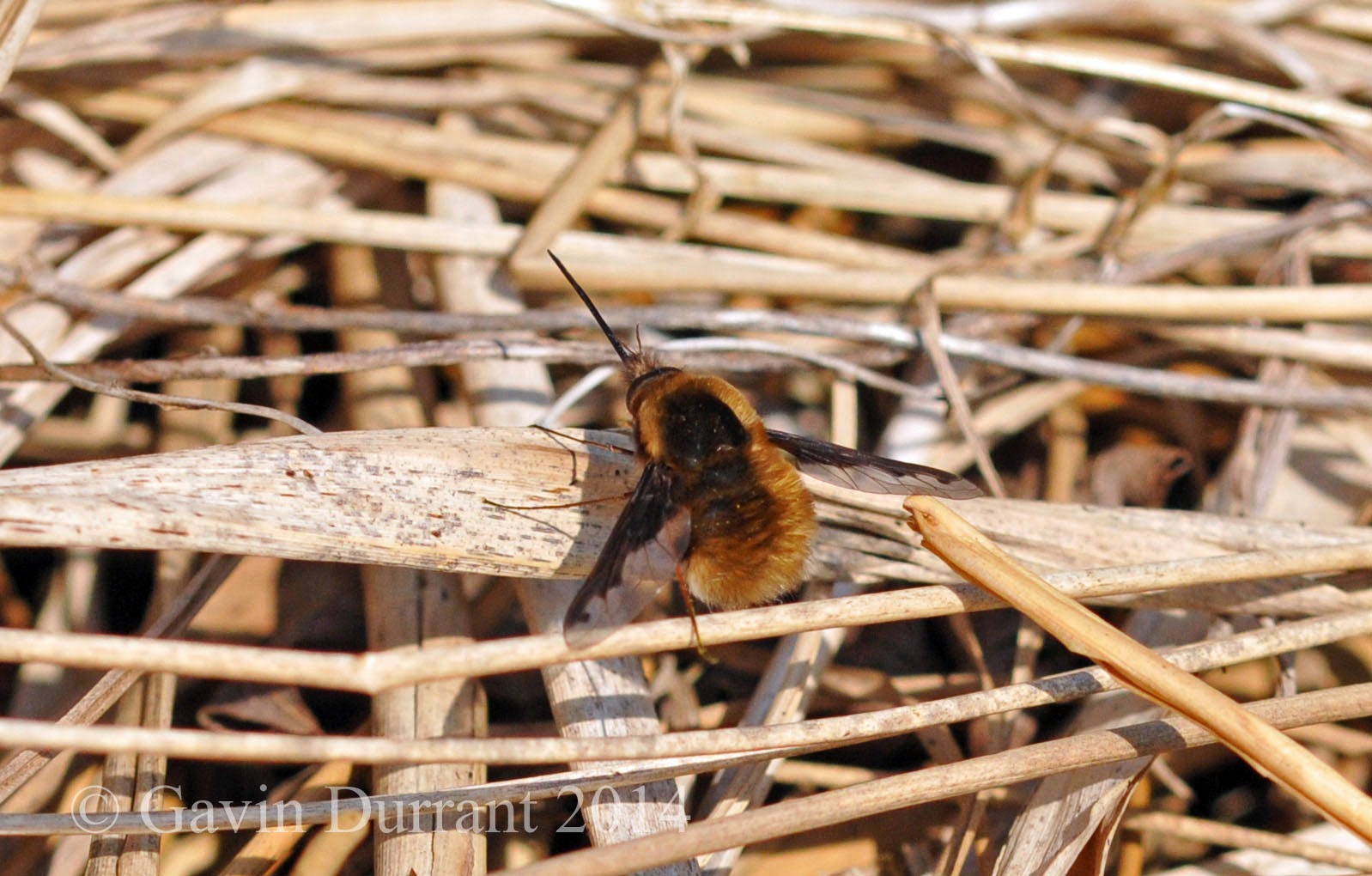With my long lens out of action at the moment this week I've concentrated on smaller subjects starting with my garden where the frogs have been active and the spawn has started to appear. Below are a couple of pictures of one of the frogs having a rest in the weed keeping its eyes on me.
Moving on to SWT North cove reserve today a variety of beetles were seen along with many butterflies including Peacocks, Small Tortoishell, Comma and Brimstone. Also in evidence were an abundance of bees and the first Bee-flies of the year but no sign of any snakes as yet. Pictured below is first, a Bloody -nosed beetle (Timarcha tenebricosa), secondly an Oieceoptoma thoraccicum beetle which is very distinctive with its orange head and then a heavily cropped photo of a Bee-fly. The Bloody nosed beetle is a very large flightless insect so called because of its ability to ooze blood from its mouth when threatened which is usually enough to deter predators.
Finally for this post a picture of a drake Pintail taken at a farm pond in Aldeby in South Norfolk in the warm afternoon sunlight.
Thoughts and photographs of a wildlife enthusiast living and working in the Waveney valley on my trips both in this area and beyond
Saturday, March 29, 2014
Saturday, March 15, 2014
SPRING IN THE GARDEN
A quick look around the garden this afternoon revealed that spring is well and truly on the way, the Cherry tree is in full flower and several bees were taking advantage of the warm conditions looking for a pollen feed. The most numerous were the Honey bees as seen above but there were also one or two Bumble bees which I think are Tree Bumblebees (Bombus hypnorum). I managed to get a shot of the bee flying as well as feeding on the Cherry, see below.
Also seen in the garden was the first white butterfly of the year for me which is a Small White butterfly that was perched on a Tulip flower. They are very common but I don't get to see many of them this time of the year and I believe that this particular example is a male.
Also seen in the garden was the first white butterfly of the year for me which is a Small White butterfly that was perched on a Tulip flower. They are very common but I don't get to see many of them this time of the year and I believe that this particular example is a male.
Saturday, March 8, 2014
WHOOPER SWANS AT LAST
Finally some settled weather saw me visit Minsmere once again primarily to see the Smew that have been resident there for the last few weeks but once again although the birds were visible they did not approach close enough for any good pictures. There is quite a bit of work going on at the reserve at the moment which may be related to BBC Springwatch being broadcast from here this season although this is yet to be confirmed but if this is the case things are going to get very busy in the coming weeks. Anyway back to my visit and though the ducks were being uncooperative the same could not be said for a pair of Whooper swans who in the late afternoon appeared in one of the pools behind the South hide coming quite close in the shade of some reeds. Soon these birds will be off back north to summer and breed in Iceland so I was glad to see them before they departed which could be any time soon with the warmer weather conditions.
After the swan encounter I made my way down to Island mere hide to hopefully watch the Starling murmuration that has been reliable for the last week or two. As dusk approached more and more people turned up in the hide to see the spectacle and eventually we saw small flocks of Starlings arrive from various directions before joining together flying over the reedbeds. Increasing numbers constantly merged with the main flock in the evening light stretching across the sky and just as the light was failing the flock compressed into a tight ball of an estimated 30-40,000 birds before diving into the reeds to roost. Although I have seen this sight before it never fails to impress and I am already looking forward to the next one.
After the swan encounter I made my way down to Island mere hide to hopefully watch the Starling murmuration that has been reliable for the last week or two. As dusk approached more and more people turned up in the hide to see the spectacle and eventually we saw small flocks of Starlings arrive from various directions before joining together flying over the reedbeds. Increasing numbers constantly merged with the main flock in the evening light stretching across the sky and just as the light was failing the flock compressed into a tight ball of an estimated 30-40,000 birds before diving into the reeds to roost. Although I have seen this sight before it never fails to impress and I am already looking forward to the next one.
Subscribe to:
Comments (Atom)

.jpg)












